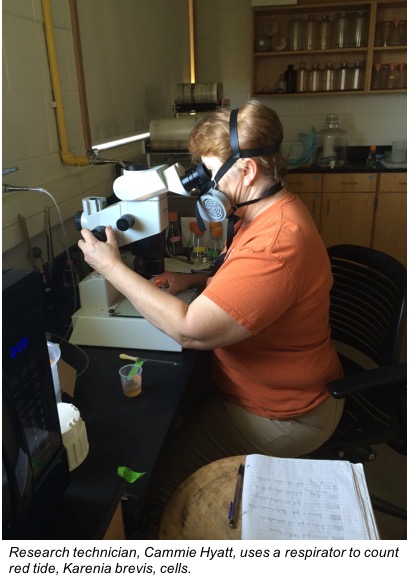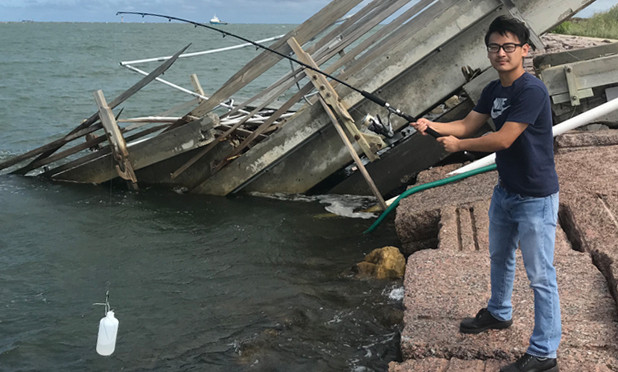 The University of Texas Marine Science Institute (UTMSI) scientists confirmed that samples from the Port Aransas Ship Channel had low to moderate numbers of Karenia brevis, which is a type of microscopic alga that can cause a red tide bloom when present in high numbers.
The University of Texas Marine Science Institute (UTMSI) scientists confirmed that samples from the Port Aransas Ship Channel had low to moderate numbers of Karenia brevis, which is a type of microscopic alga that can cause a red tide bloom when present in high numbers.
Fish aren’t the only animals affected by a red tide event. It can cause problems for humans as well. The alga that is the culprit for the red tide event produce brevetoxins, which can cause irritation to your eyes, nose and throat. In addition, eating shellfish, like oysters, that have themselves ingested the Karenia brevis, can also make people sick. When the bays have high counts of this alga, the Texas Department of State Health Services will close the bays to shellfish harvesting.
When this alga is present in dense concentration they can discolor the water and the patches of water can be reddish in color. However, color is not a reliable indicator because red tides aren’t always red. Just because the water doesn’t look red, doesn’t mean that there isn’t toxicity.
The cell count numbers are provided to Texas Parks and Wildlife Department (TPWD) which has already been alerted of the red tide event. TPWD scientists are also currently taking samples to get an estimate of the magnitude and extent of the red tide event. TPWD works with Texas Department of State Health Services to help notify the public about health concerns and issue closures of fisheries, if necessary.
General facts about red tide are available at Texas Parks and Wildlife Department's website:
https://tpwd.texas.gov/landwater/water/environconcerns/hab/redtide/faq.phtml
What is Red Tide?
• Red tides are caused by the massive growth of tiny, microscopic algae, which is a type of phytoplankton in the ocean.
• In Texas, microscopic algae named Karenia brevis often cause red tides. Massive growth of these algae gives the water a reddish color, which is why it is called a red tide.
• Karenia brevis is always present in our oceans, usually in small numbers, and only forms red tides when environmental conditions are just right for growth.
• Red tides often begin in late summer or early fall, and can last for days to months.
• Red tides move and change shape with ocean tides, currents and winds.
• Karenia brevis is a fragile algae and in rough conditions like surf it will break into small pieces and release noxious particles and chemicals into the air in wind-blown aerosols.
Is it Harmful and How Will it Affect Me?
• Karenia brevis produces chemicals called brevetoxins, which acts on the nervous system.
• Brevetoxins can cause large fish kills by paralyzing fish and preventing them from breathing.
• Irritating particles and brevetoxins in wind-blown aerosols can affect breathing in people and pets.
• Some kinds of seafood that concentrate brevetoxins can cause severe illness if consumed.
• Karenia brevis red tides are mostly just noxious but some situations call for special attention.
• Red tide aerosols can cause severe irritation of eyes, nose and throat; sneezing; and cough or difficulty breathing. People with asthma are especially sensitive to these aerosols.
• Consuming dead fish from red tide fish kills can cause severe illness in people and death of pets.
• Shellfish concentrate brevetoxins from red tides and cause severe illness if consumed.
• Fish spines and bones on the beach after a red tide can cause puncture wounds and dangerous infections from high levels of bacteria in decomposing fish.
• People and their pets are advised to avoid beaches during a red tide.
Can I Eat Fish during a Red Tide?
• Finfish caught alive are safe to eat after they have been gutted and well rinsed. Shrimp and crabs caught alive are also safe to eat.
• Commercial seafood in restaurants and grocery stores is safe to eat because it is regulated and harvested from waters free of red tide.
• It is not safe to eat fish killed from a red tide. The cooking process does not deactivate Brevetoxins.
• It is not safe to eat oysters and other filter-feeding shellfish from a red tide area. Shellfish concentrate brevetoxins during red tides and cause a serious food poisoning in humans called Neurotoxic Shellfish Poisoning.
Does UTMSI Have Scientists Working on Red Tide?
• Dr. Deana Erdner studies how red tide and other harmful algae are regulated in the ocean. Her research looks at the genetic factors and responses that control the growth and distribution of marine phytoplankton, specifically the types of phytoplankton that cause red tides and other types of harmful algae bloom events.
• Dr. Ed Buskey studies the role of plankton grazers in red tides and other harmful algal bloom dynamics. Dr. Buskey is the Mission-Aransas Reserve Research Coordinator, and is in charge of monitoring zooplankton to detect changes in plankton community dynamics. Early detection allows researchers to notify authorities when levels become too high.









